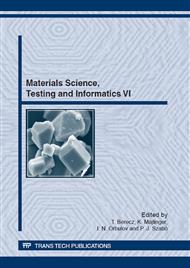p.455
p.460
p.464
p.470
p.476
p.482
p.487
p.493
p.497
Kinking Resistance of Guidewires
Abstract:
The guidewire is a small diameter, steerable wire which facilitates the navigation of the interventional devices such as stent, balloon, or coil in endovascular intervention. The guidewire has an elongated flexible body and a relatively more flexible ribbon tip. The elongated body (shaft) is tapered to the ribbon tip. The composition of the helical coil formed ribbon tip is different than the elongated body. In this article we demonstrate the correlation between the material composition and the kinking resistance of guidewire. The identified metal composition of the core wire was 18-8 stainless steel and the helical coil composed of platinum-nickel alloy and the material of tip bond was tin. The kink angle which caused permanent deformation were significantly higher on the helical coil (=68,3o) due to the higher flexibility of the helical coil than that was found on the shaft portion (=55o) (p=0,00032). The remnant angel induced by 90o kinking on the helical coil was significantly lower (=15o) than that was observed on the shaft portion (=23,9o) (p=0,00046). The deformation of the helical coil was smaller due to the higher flexible properties of the platinum-nickel alloy material against the stainless steel.
Info:
Periodical:
Pages:
476-481
Citation:
Online since:
November 2012
Authors:
Keywords:
Price:
Сopyright:
© 2013 Trans Tech Publications Ltd. All Rights Reserved
Share:
Citation:


